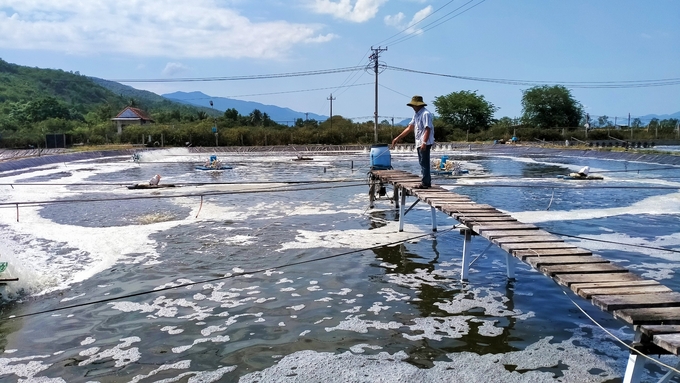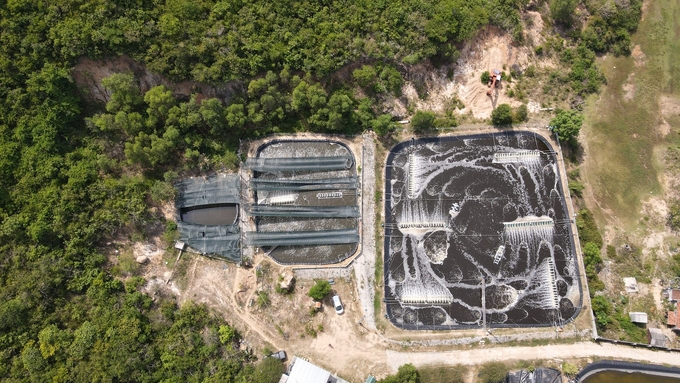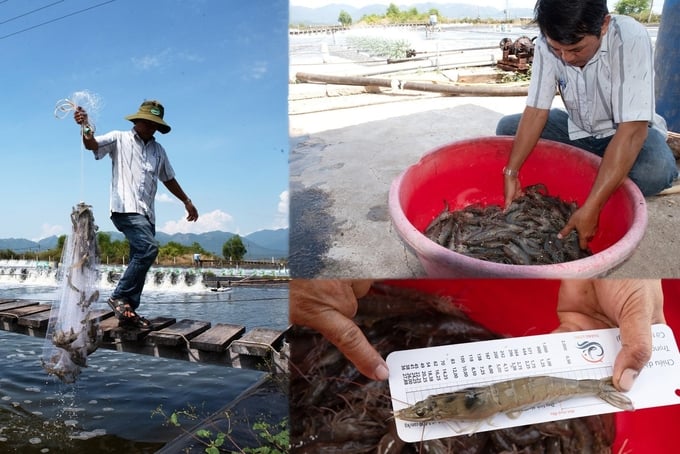November 27, 2025 | 12:58 GMT +7
November 27, 2025 | 12:58 GMT +7
Hotline: 0913.378.918
November 27, 2025 | 12:58 GMT +7
Hotline: 0913.378.918
The heatwaves in Khanh Hoa province are intense within the last few days of June. The outdoor temperature reached its highest at 40 degrees Celsius, which is very harmful for whiteleg shrimp farming.
Several shrimp farming areas in earthen ponds in the communes of Ninh Ich, Ninh Loc, Ninh Phu in Ninh Hoa town were forced to delay their stocking post-harvest. However, the tarpaulin-lined shrimp farming area belonging to Mr. Le Minh Chinh in Ninh Phu commune was different. The ponds were still stocked regularly, and the aeration fan to generate oxygen were still operating.

Mr. Chinh's shrimp farming area under operation despite the hot weather. Photo: Kim So.
According to Mr. Chinh, the majority of farmers suspended their shrimp farming operations due to the unfavorable hot weather. Furthermore, investment costs for feed, seed, and electricity have increased, whereas the prices of commercial shrimp dropped. As a result, shrimp farming is relatively unprofitable for most people.
Mr. Chinh attributed his normal farming operations to the Semi biofloc technology which combines 3 stages to help control diseases, avoid environmental pollution and reduce costs in shrimp farming.
According to Mr. Chinh, Semi biofloc not a new shrimp farming technology. This technology has helped shrimp farmers clean and stabilize the environment by microalgae. Biofloc consists of heterotrophic bacteria, algae, and humus that help purify water, provide a rich source of nutritious food for cultured subjects, and inhibit the growth of pathogenic microorganisms. As a result, farmed shrimp have a rapid growth rate, are disease-free, and guarantee food safety.
“Traditional shrimp farming poses high risk of diseases, with the most severe outbreak being EHP (Enterocytozoon hepatopenaei), and most farming methods fail to control this disease. When I switched to shrimp farming following the 3-stage combination technology, all pathogens on seeds are controlled from when they are stocked until they are harvested", Mr. Chinh shared.
On the other hand, the 3-stage shrimp farming model helps reduce feed and electricity costs. If pathogens are detected during the stocking process, the crop can be canceled prematurely to avoid heavy damage.

Mr. Chinh's 3-stage shrimp farming model in Ninh Phu commune, Ninh Hoa town, Khanh Hoa province. Photo: Kim So.
Mr. Chinh's shrimp farming model is implemented with the following stages:
At Stage 1, shrimp are stocked in a 100-square-meter tank at density of 25 to 50 thousand seed. Subsequently, shrimp are incubated for nearly 30 days. At the end of this stage, shrimp will reach a size of 1,000 and 1,200 shrimp per kilogram.
At stage 2, all shrimp are transferred to outdoor ponds that apply Semi biofloc technology. The second incubation period last for approximately 25 days. When the shrimp reaches the size of 200 to 250 shrimp per kilogram, and the density is 500 shrimp per square meter, the process moves to stage 3.
At stage 3, the stocking density is reduced by half, i.e: 250 to 300 fish per quare meter. After an incubation period of approximately 90 days, shrimp will reach an average size of 50 shrimp per kilogram.
According to Mr. Chinh's calculations, shrimp farmers can reduce the cost of feed by one-third compared to traditional farming methods during stage 1. Moreover, the electricity bill will only total to 500,000 VND due to the utilization of small capacity aerators.
During Stage 2, the cost of feed and electricity will also be cut by half compared to that of traditional farming methods. Farmers are only required to to invest in electricity and feed in Stage 3 according to the needs of the stocked shrimp.
“Thanks to this farming method, the feed coefficient rate will fall between 0.8 - 0.9, with the maximum being 1.0. Accordingly, farmers will reduce costs by nearly 20.000 VND per one kilogram of shrimp compared to the traditional farming method”, Mr. Chinh detailed.

Thanks to 3-stage Semi biofloc shrimp farming technology, Mr. Chinh has saved on input costs and increased profits. Photo: Kim So.
The production cost for 1 kilogram of farmed shrimp at the size of 100 shrimp per kilogram in the central region is reportedly 85,000 VND. Mr. Chinh's shrimp farming model helps to solve the problem of feed costs and electricity bills, which are the two main factors that raise the production cost of farmed shrimp.
Accordingly, Mr. Chinh stocked at a density of 300 shrimp per square meter for 60 days to harvest 100 shrimp per square meter. He estimated the total investment cost to be at 50,000 VND per kilogram. At the selling price of 80,000 VND per kilogram, he made a profit of 30,000 VND per kilogram of shrimp after deducting expenses.
To apply the model, Mr. Chinh's ponds are lined with canvas, and equipped with an automatic siphon system, aeration system, automatic feeding machine, and a generator. In addition to the pond system, Mr. Chinh also invested in microbial culture zones using a mixture of probiotics incubated with molasses to create biofloc that are periodically dispensed into the ponds.
Mr. Chinh has successfully applied the Semi biofloc shrimp farming technology since 2014, and customized the 3-stage shrimp farming process to the local environment.
Translated by Nguyen Hai Long
/2025/11/26/4909-2-154329_878.jpg)
(VAN) Pearl grouper farming in HDPE cages not only delivers economic efficiency but also contributes to protecting the environment, creating jobs, and promoting marine-based experiential tourism.

(VAN) The model of making a living under the forest canopy through the agroforestry system in Van Son commune, Bac Ninh province, is expected to generate an annual income of approximately VND 30 million/ha.

(VAN) Many enterprises in Can Tho are harnessing natural energy and reducing greenhouse gas emissions in their production processes, thereby contributing to the promotion of a sustainable green transition.
/2025/11/24/3536-2-112800_176.jpg)
(VAN) Dong Nai now has tens of thousands of hectares of forests certified for sustainable management, and this area will continue to be expanded in the coming period.

(VAN) Vinh Ha hamlet (Dai Xuyen commune, Hanoi) is shifting away from small-scale farming as households adopt bioscurity into their breeder chicken models.

(VAN) Heavy rains make aquatic species more vulnerable to disease. Proactive water management and high-tech systems help farmers prevent outbreaks and protect yields.

(VAN) Greenhouses are shifting production mindsets in Binh Lu commune, enabling farmers to ‘weather the sun and rain’ and secure stable vegetable harvests throughout the year.